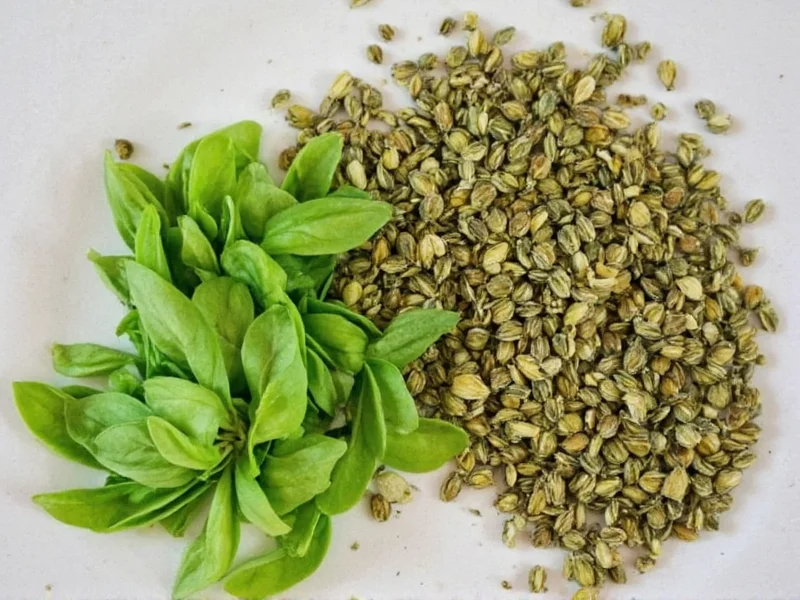2 tablespoons of fresh basil equals approximately 2/3 tablespoon (or 2 teaspoons) of dried basil. This 3:1 ratio accounts for dried basil's concentrated flavor, as the dehydration process removes moisture while intensifying essential oils. Always adjust to taste, as dried herbs lose potency over time.
Understanding Fresh to Dried Basil Conversion
When substituting dried basil for fresh in your recipes, understanding the proper conversion ratio prevents overpowering or under-seasoning your dishes. The standard culinary guideline follows a 3:1 ratio—meaning you need one-third the amount of dried basil compared to fresh. This principle applies universally across most herbs due to moisture loss during the drying process.
Why the 3:1 Ratio Matters
Fresh basil contains approximately 90% water, which evaporates during drying. What remains is a more concentrated form of the herb's essential oils and flavor compounds. When you use dried basil without adjusting measurements, you risk creating dishes with bitter, overly intense herbal notes that overpower other ingredients.
| Measurement | Fresh Basil | Dried Basil |
|---|---|---|
| Teaspoons | 3 tsp | 1 tsp |
| Tablespoons | 1 tbsp | 1/3 tbsp (1 tsp) |
| Cups | 1 cup | 1/3 cup |
Practical Application in Cooking
When converting recipes that call for 2 tablespoons fresh basil, use precisely 2 teaspoons dried basil. For optimal flavor integration:
- Add dried basil early in cooking to allow rehydration and flavor dispersion
- Crush dried leaves between your fingers before adding to release essential oils
- Start with 75% of the recommended amount, then adjust to taste
Flavor Profile Differences
Fresh basil offers bright, sweet notes with hints of anise and clove, while dried basil develops earthier, more muted characteristics. The drying process diminishes volatile compounds responsible for fresh basil's signature aroma. This flavor transformation means dried basil works better in long-simmered dishes like tomato sauces, while fresh basil shines in finished dishes like caprese salad or pesto.
Maximizing Dried Basil Quality
Proper storage maintains dried basil's potency for substitution accuracy:
- Store in airtight containers away from light and heat
- Replace dried herbs every 6-12 months for optimal flavor
- Test potency by rubbing and smelling—weak aroma indicates diminished quality
Older dried basil may require slightly increased measurements to achieve desired flavor intensity, but never exceed a 2:1 ratio to avoid bitterness.
Recipe-Specific Adjustments
Certain dishes require nuanced adjustments beyond simple measurement conversion:
- Pasta sauces: Use 1.5x the converted amount since tomatoes absorb herbal notes
- Soups and stews: Add dried basil 15 minutes before completion for balanced flavor
- Vinaigrettes: Rehydrate dried basil in warm olive oil before mixing
Remember that fresh basil's delicate compounds break down with heat, while dried basil needs moisture and time to express its full flavor potential.
Common Substitution Mistakes to Avoid
Cooks frequently make these errors when converting fresh to dried basil:
- Using equal measurements (1:1 ratio) resulting in overpowering dishes
- Adding dried basil too late in cooking, yielding harsh, unblended flavors
- Not accounting for storage duration—older dried herbs require slight measurement increases
- Substituting dried for fresh in raw applications like salads or garnishes
For best results, always taste as you cook and adjust seasoning gradually when using dried herbs.
When Fresh Basil Is Irreplaceable
Certain culinary applications demand fresh basil's unique characteristics:
- Raw preparations like pesto or chiffonade garnishes
- Dishes served immediately after preparation
- Recipes highlighting basil's bright, grassy notes
In these cases, consider alternative fresh herbs like oregano or mint rather than forcing dried basil substitution.
Frequently Asked Questions
Can I use dried basil instead of fresh in pesto?
Dried basil doesn't work well in traditional pesto because the raw preparation can't rehydrate the dried leaves properly. The resulting texture becomes gritty and the flavor lacks the bright, fresh notes essential to pesto. For best results, use fresh basil or consider alternative sauces designed for dried herbs.
How do I adjust recipes when my dried basil is older than six months?
For dried basil older than six months, increase the converted measurement by 25-50%. Start with the standard 2/3 tablespoon for 2 tablespoons fresh basil, then add small increments until desired flavor is achieved. Always crush older dried herbs thoroughly to maximize flavor release.
Why does my dish taste bitter when I substitute dried basil for fresh?
Bitterness typically occurs when using too much dried basil or adding it too late in cooking. Dried herbs contain concentrated essential oils that can become harsh when not properly rehydrated. Always use the 3:1 conversion ratio and add dried basil early enough in the cooking process to allow flavors to mellow and integrate.
Does the conversion ratio differ for different basil varieties?
Most common basil varieties (Genovese, Sweet Basil) follow the standard 3:1 fresh-to-dried ratio. However, more potent varieties like Holy Basil or Thai Basil may require a 4:1 ratio due to their stronger essential oil content. When substituting specialty basils, start with smaller amounts and adjust to taste.
Can I rehydrate dried basil to mimic fresh basil?
You can partially rehydrate dried basil by soaking 1 teaspoon in 2 tablespoons warm water or olive oil for 15-20 minutes. This works well for salad dressings or marinades but won't fully replicate fresh basil's texture and volatile compounds. The rehydrated mixture equals approximately 1 tablespoon fresh basil.











 浙公网安备
33010002000092号
浙公网安备
33010002000092号 浙B2-20120091-4
浙B2-20120091-4